Comparative Analyses of Selected Neural Networks for Prediction of Sustainable Cementitious Composite Subsurface Tensile Strength
Abstract
1. Introduction
2. Materials and Methods
2.1. Materials
2.2. Methods
2.2.1. Schmidt Hammer Test
2.2.2. Pull-Off Tests
2.2.3. Neural Networks
3. Results
3.1. Schmidt Hammer Test
3.2. Pull-Off Tests
4. Statistical Analyses of the Collected Data
5. Neural Network Analyses
6. Comparison of the Models
7. Conclusions
Author Contributions
Funding
Institutional Review Board Statement
Informed Consent Statement
Data Availability Statement
Conflicts of Interest
Appendix A
| Sample No. | Cement [kg/m3] | Dry Quartz Sand [kg/m3] | Water [kg/m3] | Granite Powder [kg/m3] | Curing Conditions | Curing Time [days] | fc [MPa] | fh [MPa] |
|---|---|---|---|---|---|---|---|---|
| 1 | 512 | 1536 | 256 | 0 | AIR | 56 | 22 | 1.23 |
| 2 | 512 | 1536 | 256 | 0 | AIR | 56 | 24 | 1.23 |
| 3 | 512 | 1536 | 256 | 0 | AIR | 56 | 27 | 1.23 |
| 4 | 512 | 1536 | 256 | 0 | AIR | 56 | 29 | 1.27 |
| 5 | 512 | 1536 | 256 | 0 | AIR | 56 | 34 | 1.27 |
| 6 | 512 | 1536 | 256 | 0 | AIR | 56 | 36 | 1.27 |
| 7 | 512 | 1536 | 256 | 0 | AIR | 56 | 32 | 1.14 |
| 8 | 512 | 1536 | 256 | 0 | AIR | 56 | 27 | 1.14 |
| 9 | 512 | 1536 | 256 | 0 | AIR | 56 | 25 | 1.14 |
| 10 | 512 | 1536 | 256 | 0 | AIR | 56 | 31 | 0.88 |
| 11 | 512 | 1536 | 256 | 0 | AIR | 56 | 36 | 0.88 |
| 12 | 512 | 1536 | 256 | 0 | AIR | 56 | 27 | 0.88 |
| 13 | 460.8 | 1536 | 256 | 51.2 | AIR | 56 | 25 | 1.18 |
| 14 | 460.8 | 1536 | 256 | 51.2 | AIR | 56 | 26 | 1.18 |
| 15 | 460.8 | 1536 | 256 | 51.2 | AIR | 56 | 26 | 1.18 |
| 16 | 460.8 | 1536 | 256 | 51.2 | AIR | 56 | 23 | 1.53 |
| 17 | 460.8 | 1536 | 256 | 51.2 | AIR | 56 | 29 | 1.53 |
| 18 | 460.8 | 1536 | 256 | 51.2 | AIR | 56 | 22 | 1.53 |
| 19 | 460.8 | 1536 | 256 | 51.2 | AIR | 56 | 24 | 1.06 |
| 20 | 460.8 | 1536 | 256 | 51.2 | AIR | 56 | 28 | 1.06 |
| 21 | 460.8 | 1536 | 256 | 51.2 | AIR | 56 | 34 | 1.06 |
| 22 | 460.8 | 1536 | 256 | 51.2 | AIR | 56 | 30 | 1.34 |
| 23 | 460.8 | 1536 | 256 | 51.2 | AIR | 56 | 34 | 1.34 |
| 24 | 460.8 | 1536 | 256 | 51.2 | AIR | 56 | 26 | 1.34 |
| 25 | 409.6 | 1536 | 256 | 102.4 | AIR | 56 | 23 | 0.88 |
| 26 | 409.6 | 1536 | 256 | 102.4 | AIR | 56 | 24 | 0.88 |
| 27 | 409.6 | 1536 | 256 | 102.4 | AIR | 56 | 25 | 0.88 |
| 28 | 409.6 | 1536 | 256 | 102.4 | AIR | 56 | 32 | 1.05 |
| 29 | 409.6 | 1536 | 256 | 102.4 | AIR | 56 | 20 | 1.05 |
| 30 | 409.6 | 1536 | 256 | 102.4 | AIR | 56 | 27 | 1.05 |
| 31 | 409.6 | 1536 | 256 | 102.4 | AIR | 56 | 28 | 0.96 |
| 32 | 409.6 | 1536 | 256 | 102.4 | AIR | 56 | 20 | 0.96 |
| 33 | 409.6 | 1536 | 256 | 102.4 | AIR | 56 | 20 | 0.96 |
| 34 | 409.6 | 1536 | 256 | 102.4 | AIR | 56 | 23 | 0.93 |
| 35 | 409.6 | 1536 | 256 | 102.4 | AIR | 56 | 25 | 0.93 |
| 36 | 409.6 | 1536 | 256 | 102.4 | AIR | 56 | 36 | 0.93 |
| 37 | 358.4 | 1536 | 256 | 153.6 | AIR | 56 | 21 | 0.87 |
| 38 | 358.4 | 1536 | 256 | 153.6 | AIR | 56 | 23 | 0.87 |
| 39 | 358.4 | 1536 | 256 | 153.6 | AIR | 56 | 14 | 0.87 |
| 40 | 358.4 | 1536 | 256 | 153.6 | AIR | 56 | 20 | 0.86 |
| 41 | 358.4 | 1536 | 256 | 153.6 | AIR | 56 | 17 | 0.86 |
| 42 | 358.4 | 1536 | 256 | 153.6 | AIR | 56 | 16 | 0.86 |
| 43 | 358.4 | 1536 | 256 | 153.6 | AIR | 56 | 30 | 0.7 |
| 44 | 358.4 | 1536 | 256 | 153.6 | AIR | 56 | 29 | 0.7 |
| 45 | 358.4 | 1536 | 256 | 153.6 | AIR | 56 | 30 | 0.7 |
| 46 | 358.4 | 1536 | 256 | 153.6 | AIR | 56 | 34 | 0.79 |
| 47 | 358.4 | 1536 | 256 | 153.6 | AIR | 56 | 29 | 0.79 |
| 48 | 358.4 | 1536 | 256 | 153.6 | AIR | 56 | 28 | 0.79 |
| 49 | 512 | 1536 | 256 | 0 | WET | 56 | 24 | 2.52 |
| 50 | 512 | 1536 | 256 | 0 | WET | 56 | 24 | 2.52 |
| 51 | 512 | 1536 | 256 | 0 | WET | 56 | 25 | 2.52 |
| 52 | 512 | 1536 | 256 | 0 | WET | 56 | 26 | 2.26 |
| 53 | 512 | 1536 | 256 | 0 | WET | 56 | 26 | 2.26 |
| 54 | 512 | 1536 | 256 | 0 | WET | 56 | 33 | 2.26 |
| 55 | 512 | 1536 | 256 | 0 | WET | 56 | 38 | 1.47 |
| 56 | 512 | 1536 | 256 | 0 | WET | 56 | 32 | 1.47 |
| 57 | 512 | 1536 | 256 | 0 | WET | 56 | 25 | 1.47 |
| 58 | 512 | 1536 | 256 | 0 | WET | 56 | 27 | 3.08 |
| 59 | 512 | 1536 | 256 | 0 | WET | 56 | 30 | 3.08 |
| 60 | 512 | 1536 | 256 | 0 | WET | 56 | 26 | 3.08 |
| 61 | 460.8 | 1536 | 256 | 51.2 | WET | 56 | 26 | 1.48 |
| 62 | 460.8 | 1536 | 256 | 51.2 | WET | 56 | 30 | 1.48 |
| 63 | 460.8 | 1536 | 256 | 51.2 | WET | 56 | 26 | 1.48 |
| 64 | 460.8 | 1536 | 256 | 51.2 | WET | 56 | 25 | 1.88 |
| 65 | 460.8 | 1536 | 256 | 51.2 | WET | 56 | 26 | 1.88 |
| 66 | 460.8 | 1536 | 256 | 51.2 | WET | 56 | 30 | 1.88 |
| 67 | 460.8 | 1536 | 256 | 51.2 | WET | 56 | 30 | 1.95 |
| 68 | 460.8 | 1536 | 256 | 51.2 | WET | 56 | 28 | 1.95 |
| 69 | 460.8 | 1536 | 256 | 51.2 | WET | 56 | 28 | 1.95 |
| 70 | 460.8 | 1536 | 256 | 51.2 | WET | 56 | 28 | 1.56 |
| 71 | 460.8 | 1536 | 256 | 51.2 | WET | 56 | 28 | 1.56 |
| 72 | 460.8 | 1536 | 256 | 51.2 | WET | 56 | 28 | 1.56 |
| 73 | 409.6 | 1536 | 256 | 102.4 | WET | 56 | 19 | 1.16 |
| 74 | 409.6 | 1536 | 256 | 102.4 | WET | 56 | 26 | 1.16 |
| 75 | 409.6 | 1536 | 256 | 102.4 | WET | 56 | 29 | 1.16 |
| 76 | 409.6 | 1536 | 256 | 102.4 | WET | 56 | 23 | 0.91 |
| 77 | 409.6 | 1536 | 256 | 102.4 | WET | 56 | 24 | 0.91 |
| 78 | 409.6 | 1536 | 256 | 102.4 | WET | 56 | 27 | 0.91 |
| 79 | 409.6 | 1536 | 256 | 102.4 | WET | 56 | 21 | 1.56 |
| 80 | 409.6 | 1536 | 256 | 102.4 | WET | 56 | 24 | 1.56 |
| 81 | 409.6 | 1536 | 256 | 102.4 | WET | 56 | 30 | 1.56 |
| 82 | 409.6 | 1536 | 256 | 102.4 | WET | 56 | 32 | 0.87 |
| 83 | 409.6 | 1536 | 256 | 102.4 | WET | 56 | 30 | 0.87 |
| 84 | 409.6 | 1536 | 256 | 102.4 | WET | 56 | 30 | 0.87 |
| 85 | 358.4 | 1536 | 256 | 153.6 | WET | 56 | 24 | 0.85 |
| 86 | 358.4 | 1536 | 256 | 153.6 | WET | 56 | 28 | 0.85 |
| 87 | 358.4 | 1536 | 256 | 153.6 | WET | 56 | 24 | 0.85 |
| 88 | 358.4 | 1536 | 256 | 153.6 | WET | 56 | 30 | 1.37 |
| 89 | 358.4 | 1536 | 256 | 153.6 | WET | 56 | 29 | 1.37 |
| 90 | 358.4 | 1536 | 256 | 153.6 | WET | 56 | 24 | 1.37 |
| 91 | 358.4 | 1536 | 256 | 153.6 | WET | 56 | 25 | 1.04 |
| 92 | 358.4 | 1536 | 256 | 153.6 | WET | 56 | 20 | 1.04 |
| 93 | 358.4 | 1536 | 256 | 153.6 | WET | 56 | 27 | 1.04 |
| 94 | 358.4 | 1536 | 256 | 153.6 | WET | 56 | 20 | 1.21 |
| 95 | 358.4 | 1536 | 256 | 153.6 | WET | 56 | 30 | 1.21 |
| 96 | 358.4 | 1536 | 256 | 153.6 | WET | 56 | 26 | 1.21 |
| 97 | 512 | 1536 | 256 | 0 | AIR | 90 | 22 | 1.6 |
| 98 | 512 | 1536 | 256 | 0 | AIR | 90 | 24 | 1.6 |
| 99 | 512 | 1536 | 256 | 0 | AIR | 90 | 27 | 1.6 |
| 100 | 512 | 1536 | 256 | 0 | AIR | 90 | 29 | 1.33 |
| 101 | 512 | 1536 | 256 | 0 | AIR | 90 | 34 | 1.33 |
| 102 | 512 | 1536 | 256 | 0 | AIR | 90 | 36 | 1.33 |
| 103 | 512 | 1536 | 256 | 0 | AIR | 90 | 32 | 1.17 |
| 104 | 512 | 1536 | 256 | 0 | AIR | 90 | 27 | 1.17 |
| 105 | 512 | 1536 | 256 | 0 | AIR | 90 | 25 | 1.17 |
| 106 | 512 | 1536 | 256 | 0 | AIR | 90 | 31 | 1.14 |
| 107 | 512 | 1536 | 256 | 0 | AIR | 90 | 36 | 1.14 |
| 108 | 512 | 1536 | 256 | 0 | AIR | 90 | 27 | 1.14 |
| 109 | 460.8 | 1536 | 256 | 51.2 | AIR | 90 | 25 | 1.28 |
| 110 | 460.8 | 1536 | 256 | 51.2 | AIR | 90 | 26 | 1.28 |
| 111 | 460.8 | 1536 | 256 | 51.2 | AIR | 90 | 26 | 1.28 |
| 112 | 460.8 | 1536 | 256 | 51.2 | AIR | 90 | 23 | 1.69 |
| 113 | 460.8 | 1536 | 256 | 51.2 | AIR | 90 | 29 | 1.69 |
| 114 | 460.8 | 1536 | 256 | 51.2 | AIR | 90 | 22 | 1.69 |
| 115 | 460.8 | 1536 | 256 | 51.2 | AIR | 90 | 24 | 1.39 |
| 116 | 460.8 | 1536 | 256 | 51.2 | AIR | 90 | 28 | 1.39 |
| 117 | 460.8 | 1536 | 256 | 51.2 | AIR | 90 | 34 | 1.39 |
| 118 | 460.8 | 1536 | 256 | 51.2 | AIR | 90 | 30 | 1.22 |
| 119 | 460.8 | 1536 | 256 | 51.2 | AIR | 90 | 34 | 1.22 |
| 120 | 460.8 | 1536 | 256 | 51.2 | AIR | 90 | 26 | 1.22 |
| 121 | 409.6 | 1536 | 256 | 102.4 | AIR | 90 | 23 | 0.85 |
| 122 | 409.6 | 1536 | 256 | 102.4 | AIR | 90 | 24 | 0.85 |
| 123 | 409.6 | 1536 | 256 | 102.4 | AIR | 90 | 25 | 0.85 |
| 124 | 409.6 | 1536 | 256 | 102.4 | AIR | 90 | 32 | 1.05 |
| 125 | 409.6 | 1536 | 256 | 102.4 | AIR | 90 | 20 | 1.05 |
| 126 | 409.6 | 1536 | 256 | 102.4 | AIR | 90 | 27 | 1.05 |
| 127 | 409.6 | 1536 | 256 | 102.4 | AIR | 90 | 28 | 1.05 |
| 128 | 409.6 | 1536 | 256 | 102.4 | AIR | 90 | 20 | 1.05 |
| 129 | 409.6 | 1536 | 256 | 102.4 | AIR | 90 | 20 | 1.05 |
| 130 | 409.6 | 1536 | 256 | 102.4 | AIR | 90 | 23 | 0.91 |
| 131 | 409.6 | 1536 | 256 | 102.4 | AIR | 90 | 25 | 0.91 |
| 132 | 409.6 | 1536 | 256 | 102.4 | AIR | 90 | 36 | 0.91 |
| 133 | 358.4 | 1536 | 256 | 153.6 | AIR | 90 | 21 | 0.93 |
| 134 | 358.4 | 1536 | 256 | 153.6 | AIR | 90 | 23 | 0.93 |
| 135 | 358.4 | 1536 | 256 | 153.6 | AIR | 90 | 14 | 0.93 |
| 136 | 358.4 | 1536 | 256 | 153.6 | AIR | 90 | 20 | 0.9 |
| 137 | 358.4 | 1536 | 256 | 153.6 | AIR | 90 | 17 | 0.9 |
| 138 | 358.4 | 1536 | 256 | 153.6 | AIR | 90 | 16 | 0.9 |
| 139 | 358.4 | 1536 | 256 | 153.6 | AIR | 90 | 30 | 0.97 |
| 140 | 358.4 | 1536 | 256 | 153.6 | AIR | 90 | 29 | 0.97 |
| 141 | 358.4 | 1536 | 256 | 153.6 | AIR | 90 | 30 | 0.97 |
| 142 | 358.4 | 1536 | 256 | 153.6 | AIR | 90 | 34 | 1.14 |
| 143 | 358.4 | 1536 | 256 | 153.6 | AIR | 90 | 29 | 1.14 |
| 144 | 358.4 | 1536 | 256 | 153.6 | AIR | 90 | 28 | 1.14 |
| 145 | 512 | 1536 | 256 | 0 | WET | 90 | 24 | 1.99 |
| 146 | 512 | 1536 | 256 | 0 | WET | 90 | 24 | 1.99 |
| 147 | 512 | 1536 | 256 | 0 | WET | 90 | 25 | 1.99 |
| 148 | 512 | 1536 | 256 | 0 | WET | 90 | 26 | 2.28 |
| 149 | 512 | 1536 | 256 | 0 | WET | 90 | 26 | 2.28 |
| 150 | 512 | 1536 | 256 | 0 | WET | 90 | 33 | 2.28 |
| 151 | 512 | 1536 | 256 | 0 | WET | 90 | 38 | 1.77 |
| 152 | 512 | 1536 | 256 | 0 | WET | 90 | 32 | 1.77 |
| 153 | 512 | 1536 | 256 | 0 | WET | 90 | 25 | 1.77 |
| 154 | 512 | 1536 | 256 | 0 | WET | 90 | 27 | 1.74 |
| 155 | 512 | 1536 | 256 | 0 | WET | 90 | 30 | 1.74 |
| 156 | 512 | 1536 | 256 | 0 | WET | 90 | 26 | 1.74 |
| 157 | 460.8 | 1536 | 256 | 51.2 | WET | 90 | 26 | 1.56 |
| 158 | 460.8 | 1536 | 256 | 51.2 | WET | 90 | 30 | 1.56 |
| 159 | 460.8 | 1536 | 256 | 51.2 | WET | 90 | 26 | 1.56 |
| 160 | 460.8 | 1536 | 256 | 51.2 | WET | 90 | 25 | 1.32 |
| 161 | 460.8 | 1536 | 256 | 51.2 | WET | 90 | 26 | 1.32 |
| 162 | 460.8 | 1536 | 256 | 51.2 | WET | 90 | 30 | 1.32 |
| 163 | 460.8 | 1536 | 256 | 51.2 | WET | 90 | 30 | 1.56 |
| 164 | 460.8 | 1536 | 256 | 51.2 | WET | 90 | 28 | 1.56 |
| 165 | 460.8 | 1536 | 256 | 51.2 | WET | 90 | 28 | 1.56 |
| 166 | 460.8 | 1536 | 256 | 51.2 | WET | 90 | 28 | 1.55 |
| 167 | 460.8 | 1536 | 256 | 51.2 | WET | 90 | 28 | 1.55 |
| 168 | 460.8 | 1536 | 256 | 51.2 | WET | 90 | 28 | 1.55 |
| 169 | 409.6 | 1536 | 256 | 102.4 | WET | 90 | 19 | 1.57 |
| 170 | 409.6 | 1536 | 256 | 102.4 | WET | 90 | 26 | 1.57 |
| 171 | 409.6 | 1536 | 256 | 102.4 | WET | 90 | 29 | 1.57 |
| 172 | 409.6 | 1536 | 256 | 102.4 | WET | 90 | 23 | 1.3 |
| 173 | 409.6 | 1536 | 256 | 102.4 | WET | 90 | 24 | 1.3 |
| 174 | 409.6 | 1536 | 256 | 102.4 | WET | 90 | 27 | 1.3 |
| 175 | 409.6 | 1536 | 256 | 102.4 | WET | 90 | 21 | 1.18 |
| 176 | 409.6 | 1536 | 256 | 102.4 | WET | 90 | 24 | 1.18 |
| 177 | 409.6 | 1536 | 256 | 102.4 | WET | 90 | 30 | 1.18 |
| 178 | 409.6 | 1536 | 256 | 102.4 | WET | 90 | 32 | 1.44 |
| 179 | 409.6 | 1536 | 256 | 102.4 | WET | 90 | 30 | 1.44 |
| 180 | 409.6 | 1536 | 256 | 102.4 | WET | 90 | 30 | 1.44 |
| 181 | 358.4 | 1536 | 256 | 153.6 | WET | 90 | 24 | 1.37 |
| 182 | 358.4 | 1536 | 256 | 153.6 | WET | 90 | 28 | 1.37 |
| 183 | 358.4 | 1536 | 256 | 153.6 | WET | 90 | 24 | 1.37 |
| 184 | 358.4 | 1536 | 256 | 153.6 | WET | 90 | 30 | 1.35 |
| 185 | 358.4 | 1536 | 256 | 153.6 | WET | 90 | 29 | 1.35 |
| 186 | 358.4 | 1536 | 256 | 153.6 | WET | 90 | 24 | 1.35 |
| 187 | 358.4 | 1536 | 256 | 153.6 | WET | 90 | 25 | 1.13 |
| 188 | 358.4 | 1536 | 256 | 153.6 | WET | 90 | 20 | 1.13 |
| 189 | 358.4 | 1536 | 256 | 153.6 | WET | 90 | 27 | 1.13 |
| 190 | 358.4 | 1536 | 256 | 153.6 | WET | 90 | 20 | 1.56 |
| 191 | 358.4 | 1536 | 256 | 153.6 | WET | 90 | 30 | 1.56 |
| 192 | 358.4 | 1536 | 256 | 153.6 | WET | 90 | 26 | 1.56 |
References
- Danish, A.; Ozbakkaloglu, T. Greener cementitious composites incorporating sewage sludge ash as cement replacement: A review of progress, potentials, and future prospects. J. Clean. Prod. 2022, 371, 133364. [Google Scholar] [CrossRef]
- Nadim Hasoun, M.; Al-Manaseer, A. Structural Concrete: Theory and Design, 7th ed.; Wiley: Hoboken, NJ, USA, 2020; ISBN 978-1-119-60512-6. [Google Scholar]
- Herath, C.; Gunasekara, C.; Law, D.W.; Setunge, S. Performance of high volume fly ash concrete incorporating additives: A systematic literature review. Constr. Build. Mater. 2020, 258, 120606. [Google Scholar] [CrossRef]
- Czarnecki, S. Modelling of Mechanical Properties of Eco-Friendly Cementitious Composites Used in Floors: State of the Art and Research Gaps. Chem. Eng. Trans. 2022, 94, 403–408. [Google Scholar]
- Chajec, A.; Chowaniec, A.; Królicka, A.; Sadowski, Ł.; Żak, A.; Piechowka-Mielnik, M.; Savija, B. Engineering of green cementitious composites modified with siliceous fly ash: Understanding the importance of curing conditions. Constr. Build. Mater. 2021, 313, 125209. [Google Scholar] [CrossRef]
- Chajec, A. Towards the Cleaner Production of Cementitious Materials with the Synergistic Addition of Granite Powder Waste and Fly Ash. Chem. Eng. Trans. 2022, 94, 289–294. [Google Scholar]
- Malla, P.; Khedmatgozar Dolati, S.S.; Ortiz, J.D.; Mehrabi, A.B.; Nanni, A.; Dinh, K. Feasibility of Conventional Non-Destructive Testing Methods in Detecting Embedded FRP Reinforcements. Appl. Sci. 2023, 13, 4399. [Google Scholar] [CrossRef]
- Łątka, D. Prediction of Mortar Compressive Strength Based on Modern Minor-Destructive Tests. Materials 2023, 16, 2402. [Google Scholar] [CrossRef] [PubMed]
- Kazemi, M.; Madandoust, R.; De Brito, J. Compressive strength assessment of recycled aggregate concrete using Schmidt rebound hammer and core testing. Constr. Build. Mater. 2019, 224, 630–638. [Google Scholar] [CrossRef]
- ASTM, C805; Standard Test Method for Rebound Number of Hardened Concrete. ASTM International: West Conshohocken, PA, USA, 2019.
- Cacciari, P.P.; Futai, M.M. Assessing the tensile strength of rocks and geological discontinuities via pull-off tests. Int. J. Rock Mech. Min. Sci. 2018, 105, 44–52. [Google Scholar] [CrossRef]
- Pereira, E.; De Mereiros, M.H.F. Pull Off test to evaluate the compressive strength of concrete: An alternative to Brazilian standard techniques. Ibracon Struct. Mater. J. 2021, 5, 757–780. [Google Scholar] [CrossRef]
- Kos, Ž.; Kroviakov, S.; Kryzhanovskyi, V.; Hedulian, D. Strength, Frost Resistance, and Resistance to Acid Attacks on Fiber-Reinforced Concrete for Industrial Floors and Road Pavements with Steel and Polypropylene Fibers. Materials 2022, 15, 8339. [Google Scholar] [CrossRef]
- Martini, R.; Carvalho, J.; Arede, A.; Varum, H. Validation of nondestructive methods for assessing stone masonry using artificial neural networks. J. Build. Eng. 2021, 42, 102469. [Google Scholar] [CrossRef]
- Le, T.-T.; Skentou, A.D.; Mamou, A.; Asteris, P.G. Correlating the Unconfined Compressive Strength of Rock with the Compressional Wave Velocity Effective Porosity and Schmidt Hammer Rebound Number Using Artificial Neural Networks. Rock Mech. Rock Eng. 2022, 55, 6805–6840. [Google Scholar] [CrossRef]
- Almasaeid, H.H.; Suleiman, A.; Alawneh, R. Assessment of high-temperature damaged concrete using non-destructive tests and artificial neural network modelling. Case Stud. Constr. Mater. 2022, 16, e01080. [Google Scholar] [CrossRef]
- Saleem, M. Assessing the load carrying capacity of concrete anchor bolts using non-destructive tests and artificial multilayer neural network. J. Build. Eng. 2020, 30, 101260. [Google Scholar] [CrossRef]
- PN-EN 12504-2; Testing of Concrete in Structures—Part 2: Non-Destructive Testing—Determination of Reflection Number. Polish Committee for Standardization: Warsaw, Poland, 2021.
- ASTM, D 4541; Standard Test Method for Pull-Off Strength of Coatings Using Portable Adhesion Testers. ASTM International: West Conshohocken, PA, USA, 2017.
- Sadowski, Ł.; Hoła, J. New nondestructive way of identifying the values of pull-off adhesion between concrete layers in floors. J. Civ. Eng. Manag. 2014, 20, 561–569. [Google Scholar] [CrossRef]
- Czarnecki, S.; Sadowski, Ł.; Hoła, J. Evaluation of interlayer bonding in layered composites based on non-destructive measurements and machine learning: Comparative analysis of selected learning algorithms. Autom. Constr. 2021, 132, 103977. [Google Scholar] [CrossRef]
- Karthiyaini, S.; Senthamaraikannan, K.; Priyadarshini, J.; Gupta, K.; Shanmugasundaram, M. Prediction of mechanical strength of fiber admixed concrete using multiple regression analysis and artificial neural network. Adv. Mater. Sci. Eng. 2019, 2019, 4654070. [Google Scholar] [CrossRef]
- Nikoo, M.; Torabian Moghadam, F.; Sadowski, Ł. Prediction of concrete compressive strength by evolutionary artificial neural networks. Adv. Mater. Sci. Eng. 2015, 2015, 849126. [Google Scholar] [CrossRef]
- Asteris, P.G.; Skentou, A.D.; Bardhan, A.; Samui, P.; Pilakoutas, K. Predicting concrete compressive strength using hybrid ensembling of surrogate machine learning models. Cem. Concr. Res. 2021, 145, 106449. [Google Scholar] [CrossRef]
- Czarnecki, S.; Sadowski, Ł.; Hoła, J. Artificial neural networks for non-destructive identification of the interlayer bonding between repair overlay and concrete substrate. Adv. Eng. Softw. 2020, 141, 102769. [Google Scholar] [CrossRef]
- Czarnecki, S.; Shariq, M.; Nikoo, M.; Sadowski, Ł. An intelligent model for the prediction of the compressive strength of cementitious composites with ground granulated blast furnace slag based on ultrasonic pulse velocity measurements. Measurement 2021, 172, 108951. [Google Scholar] [CrossRef]
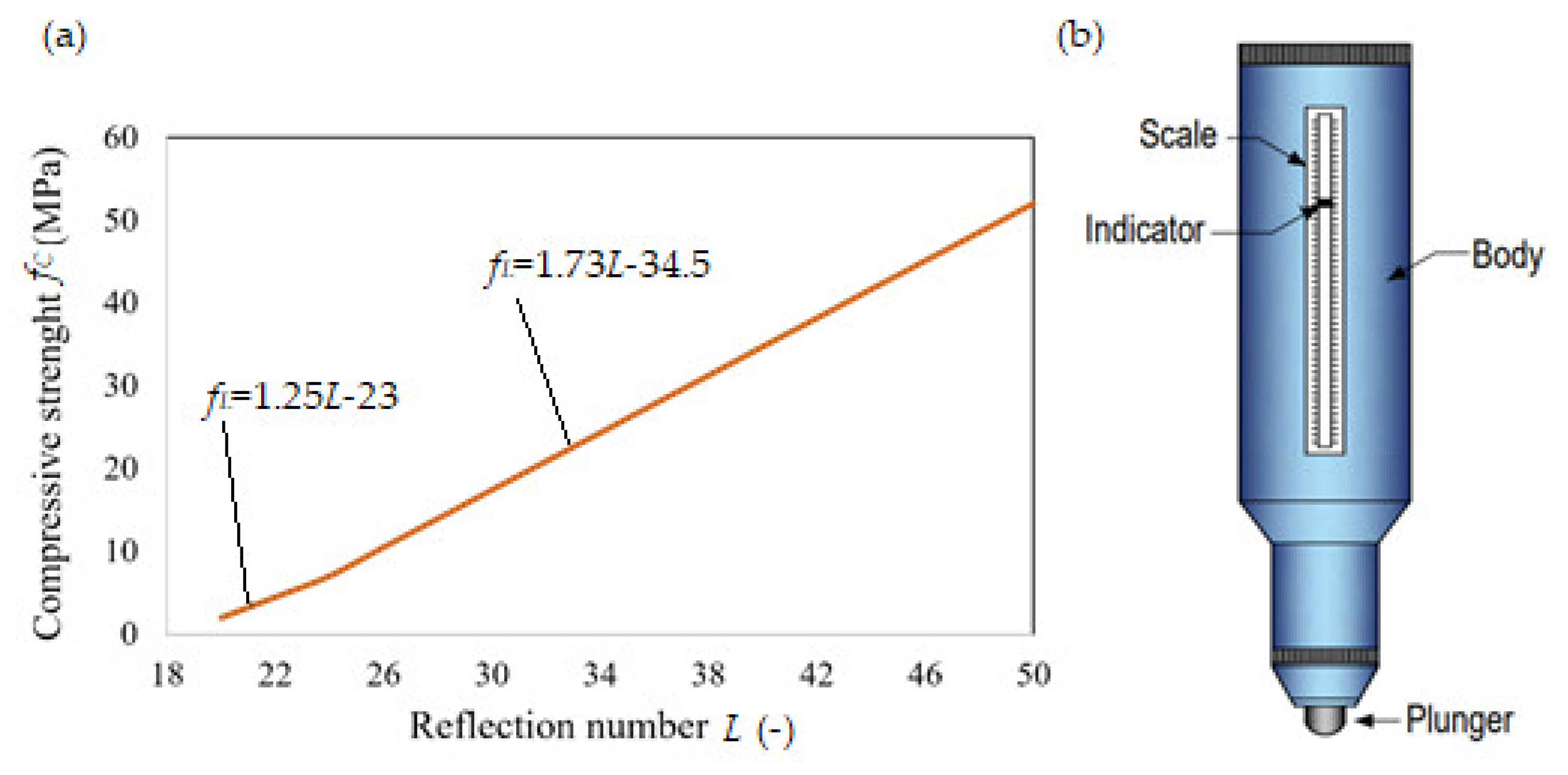

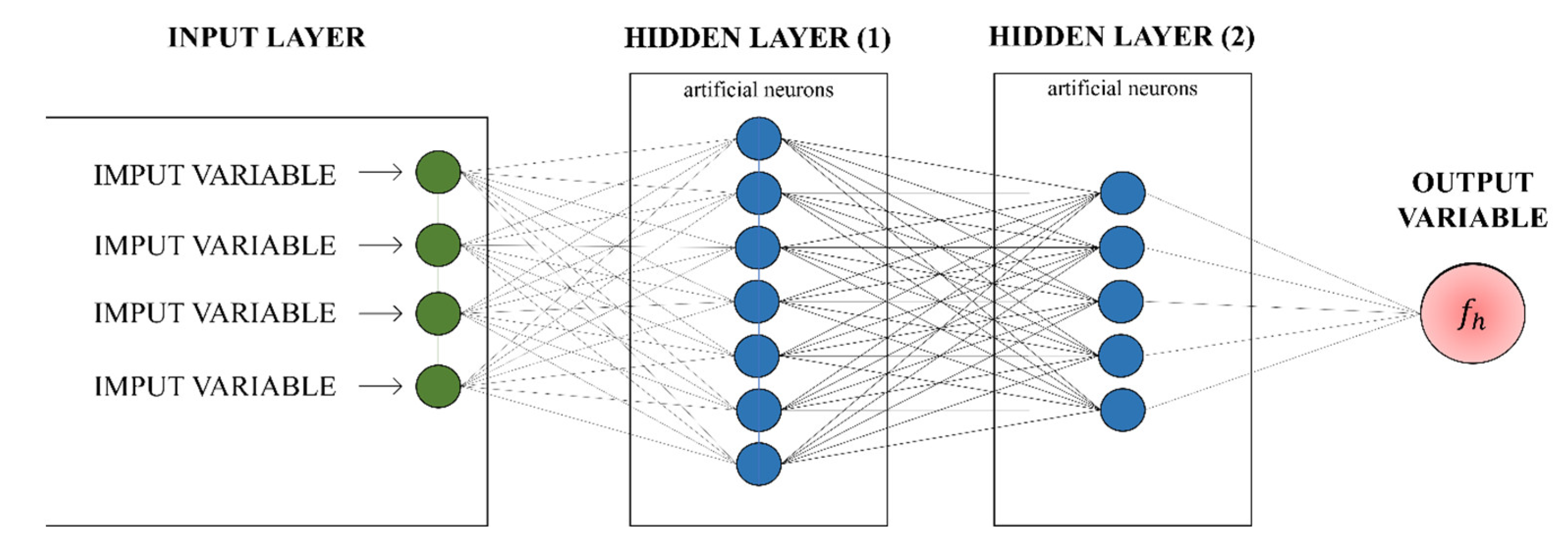
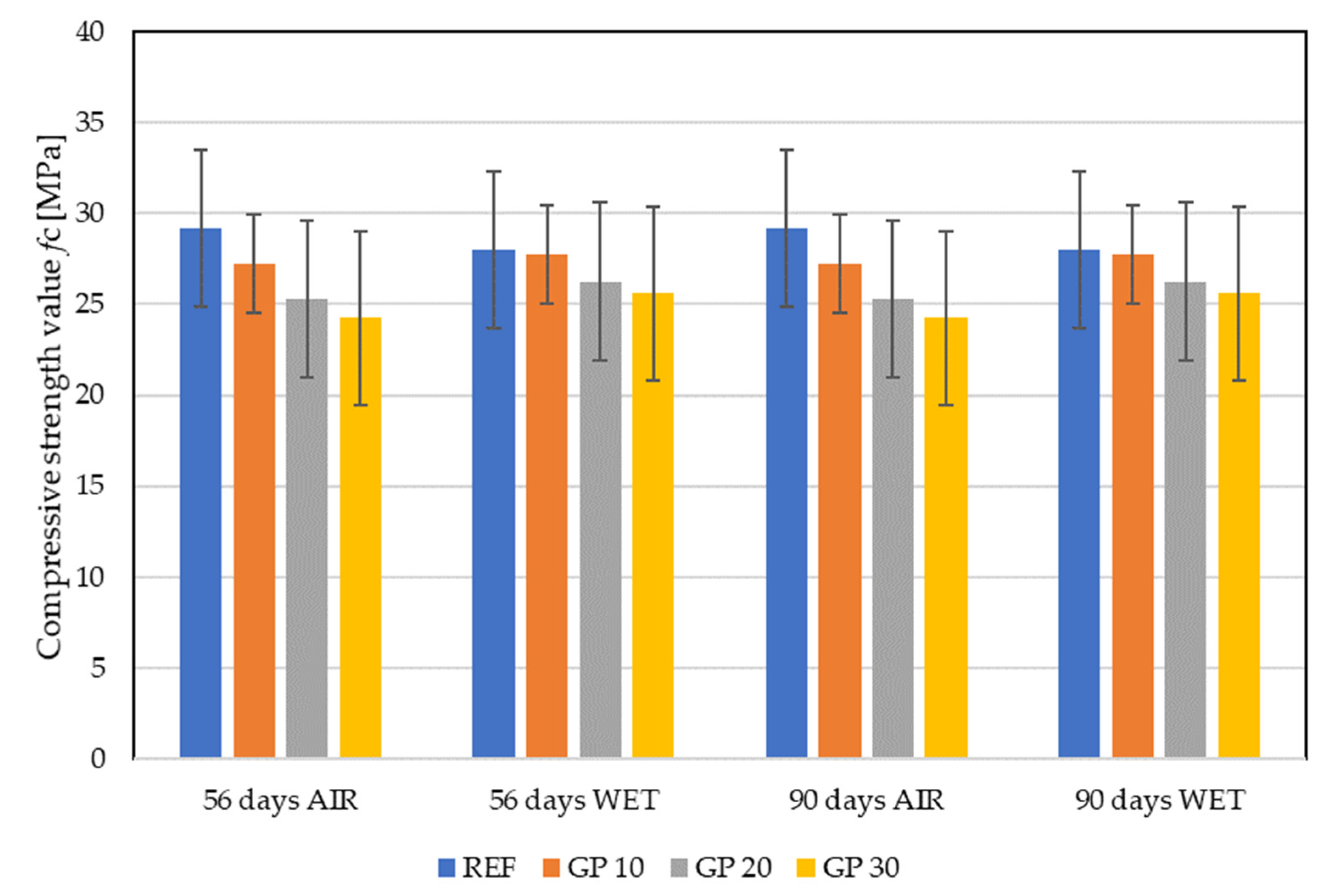
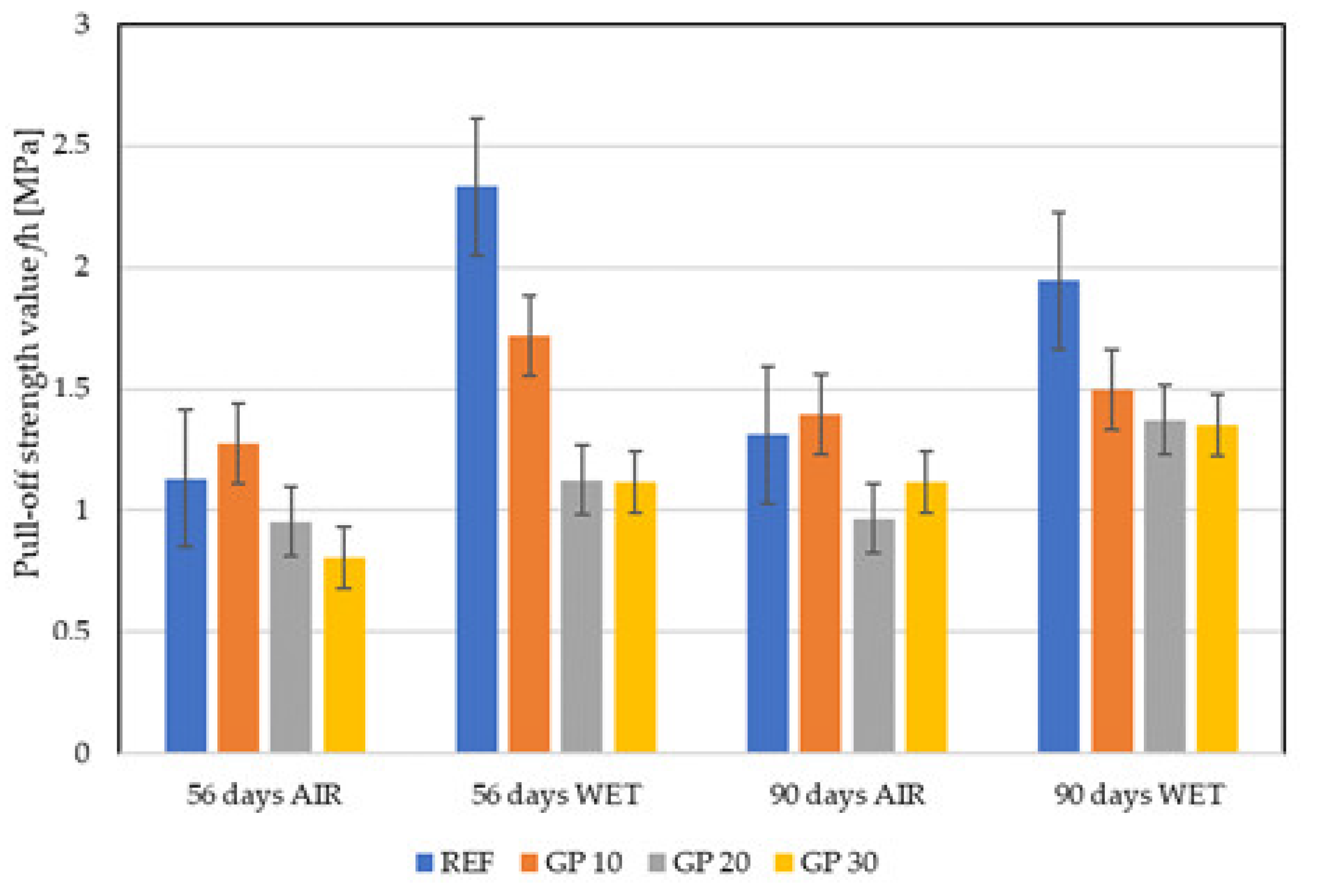
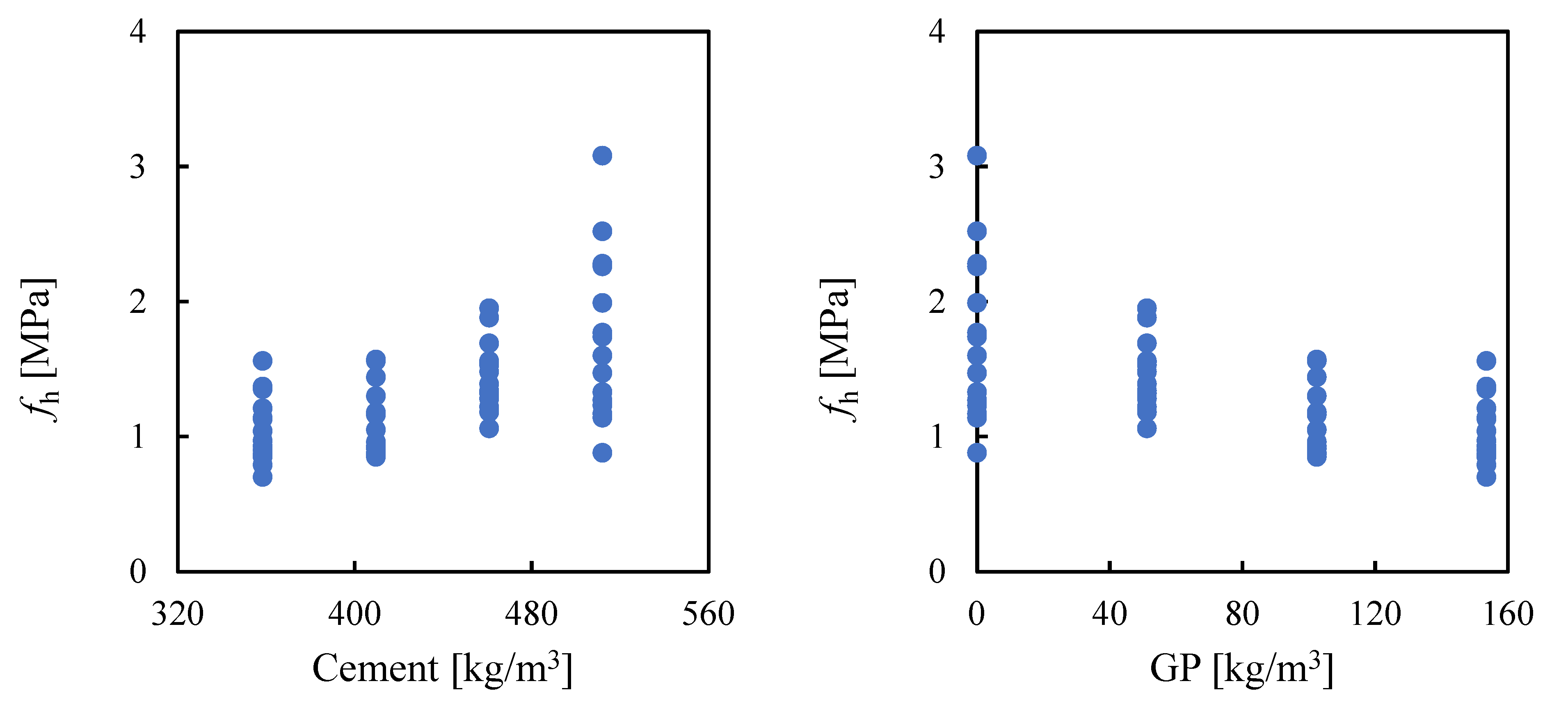
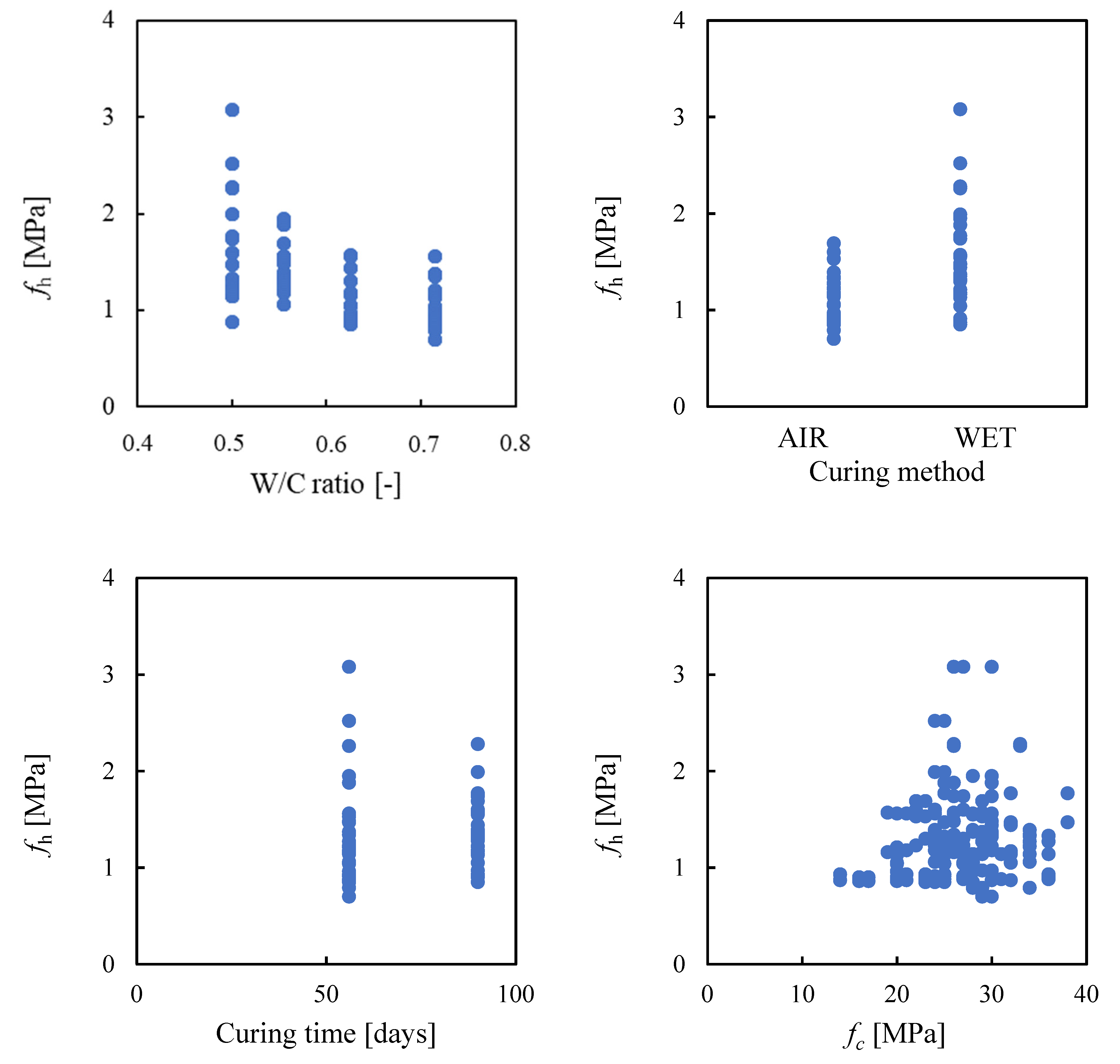

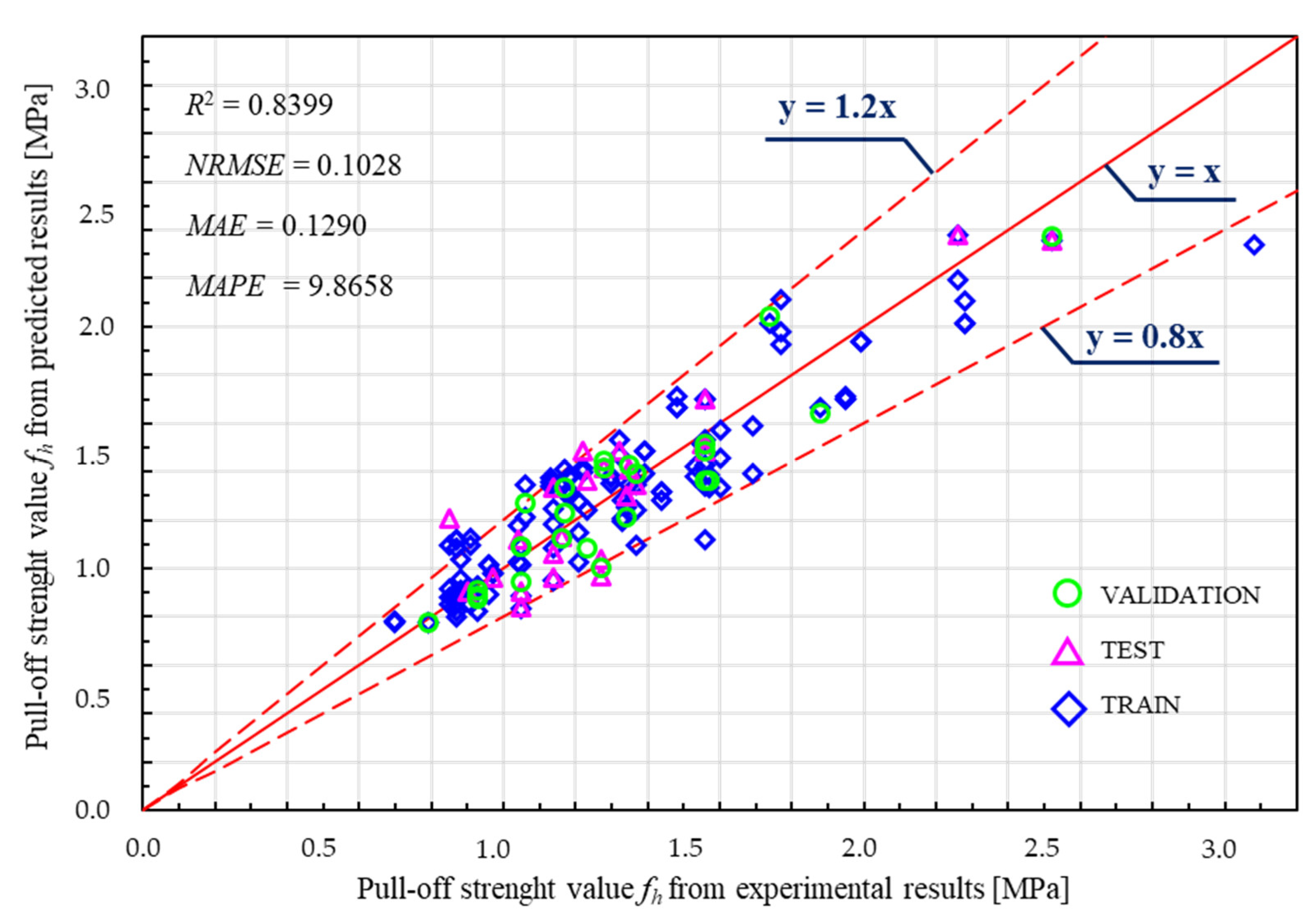
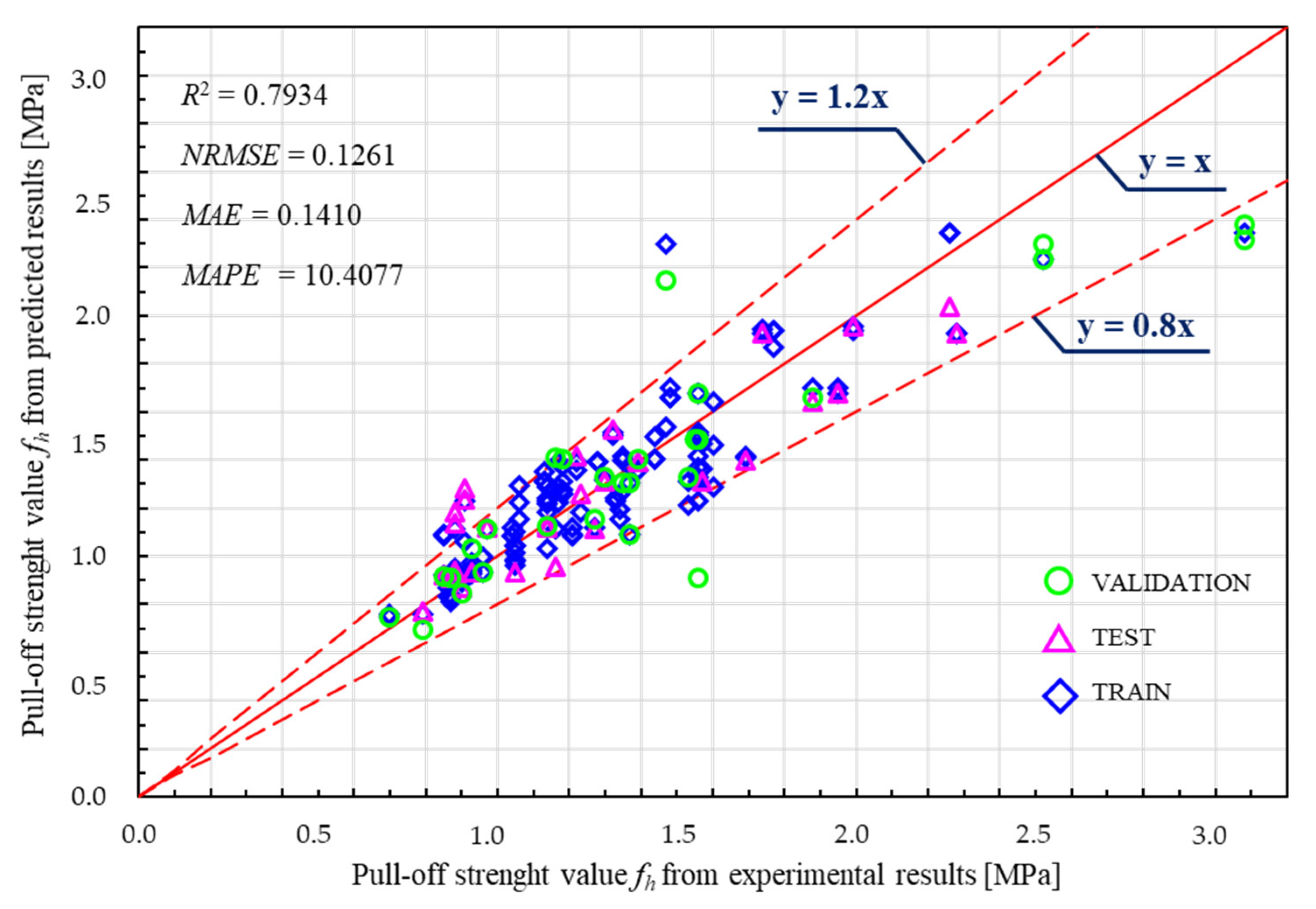

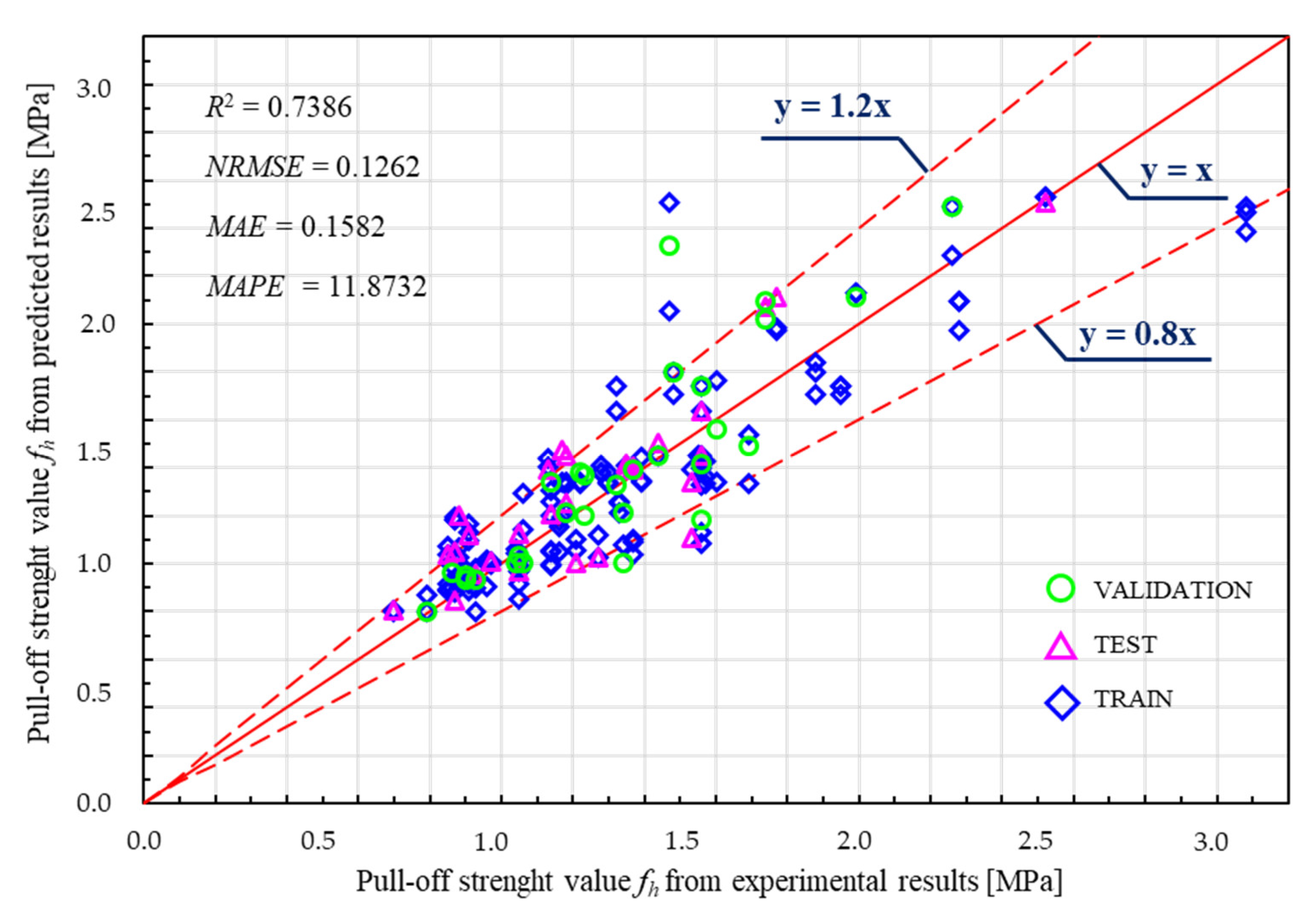
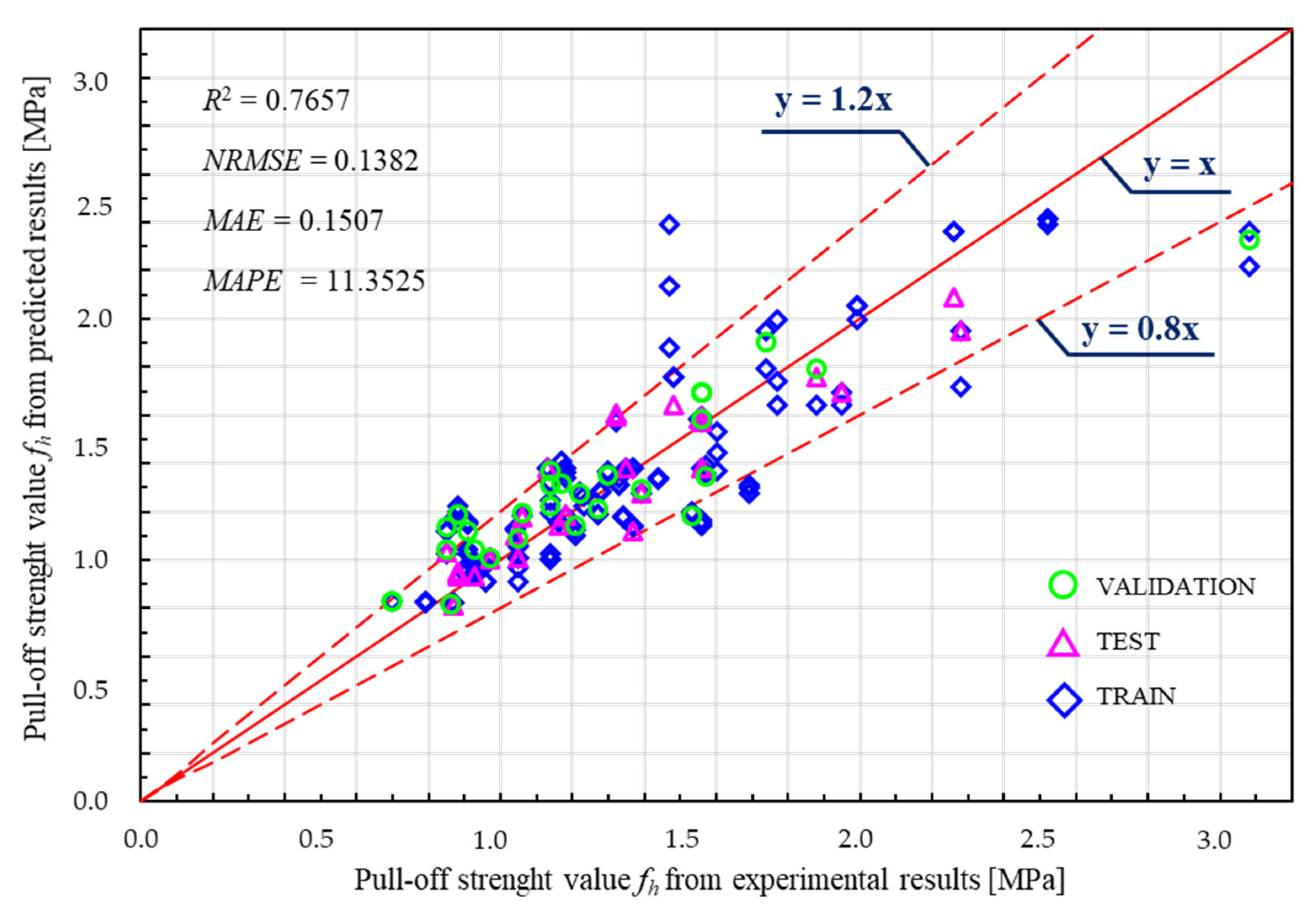
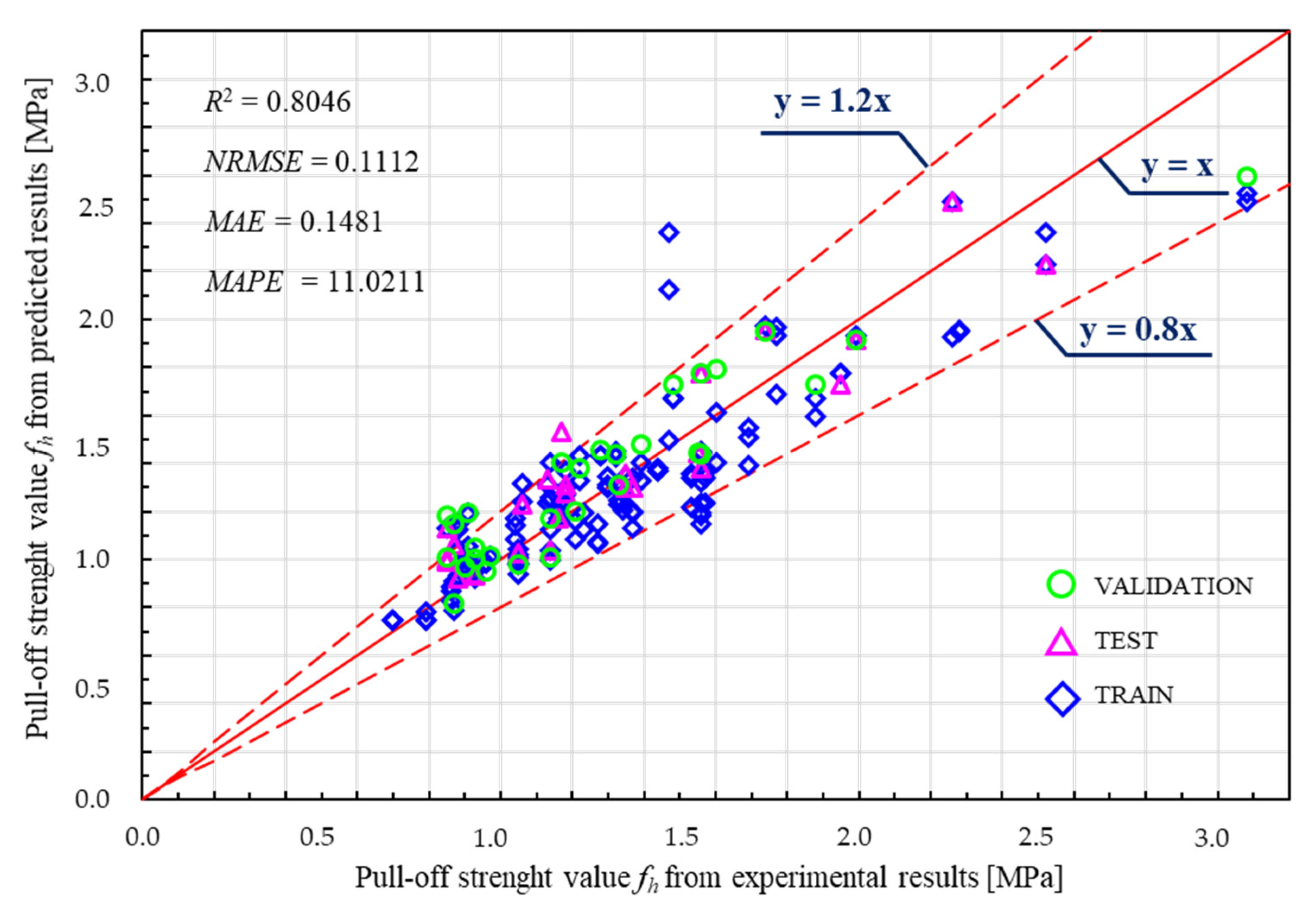
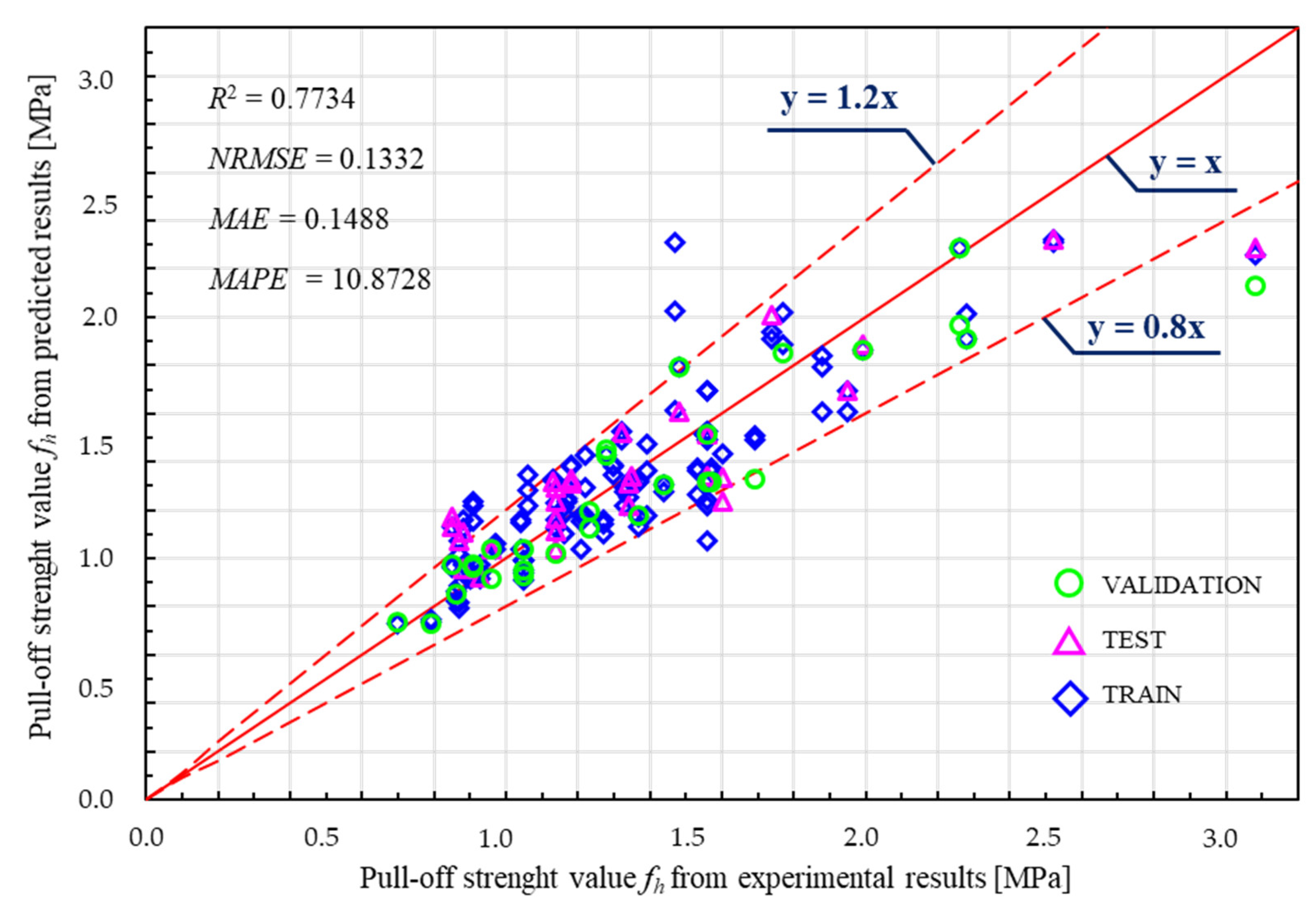
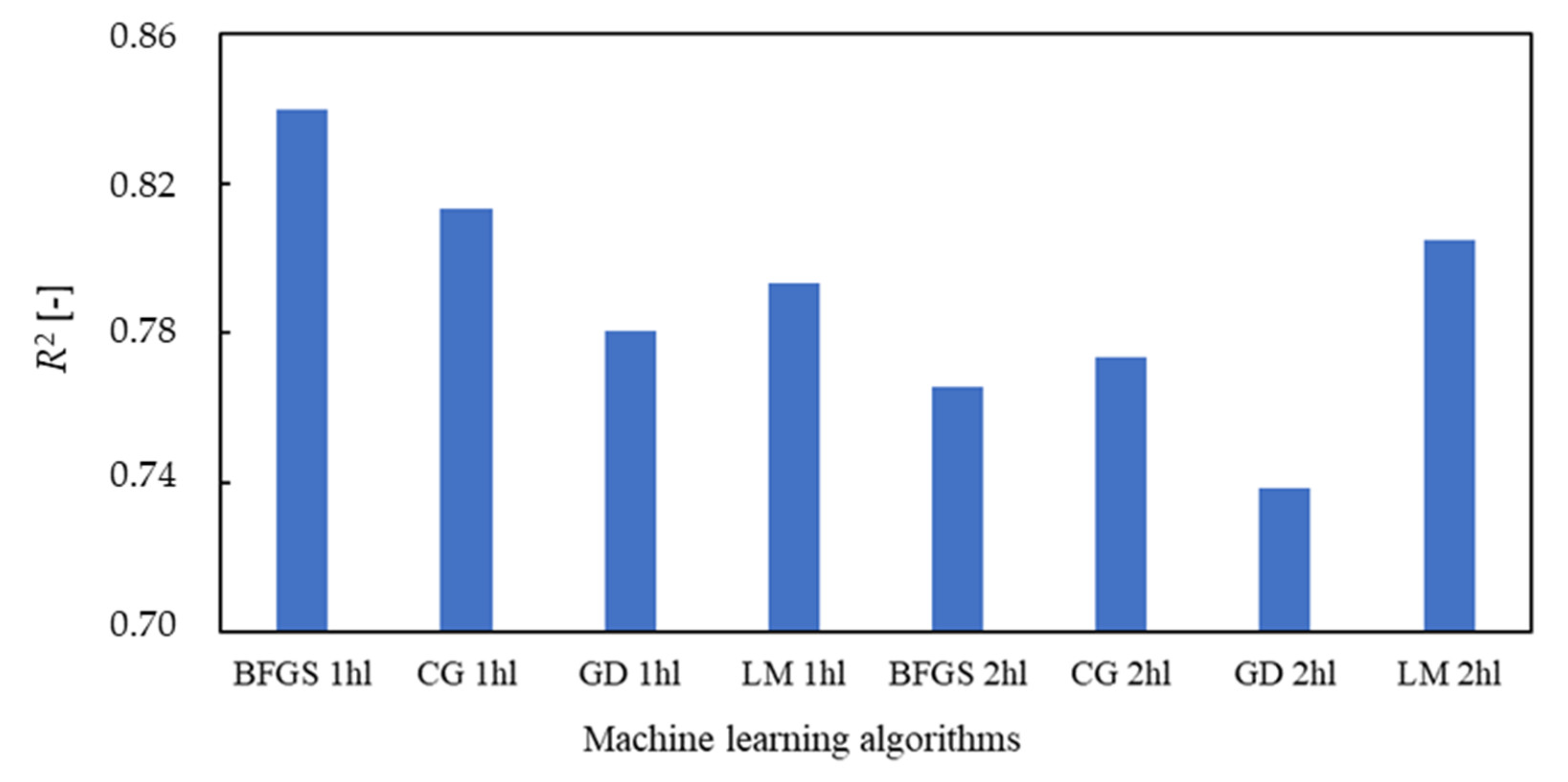
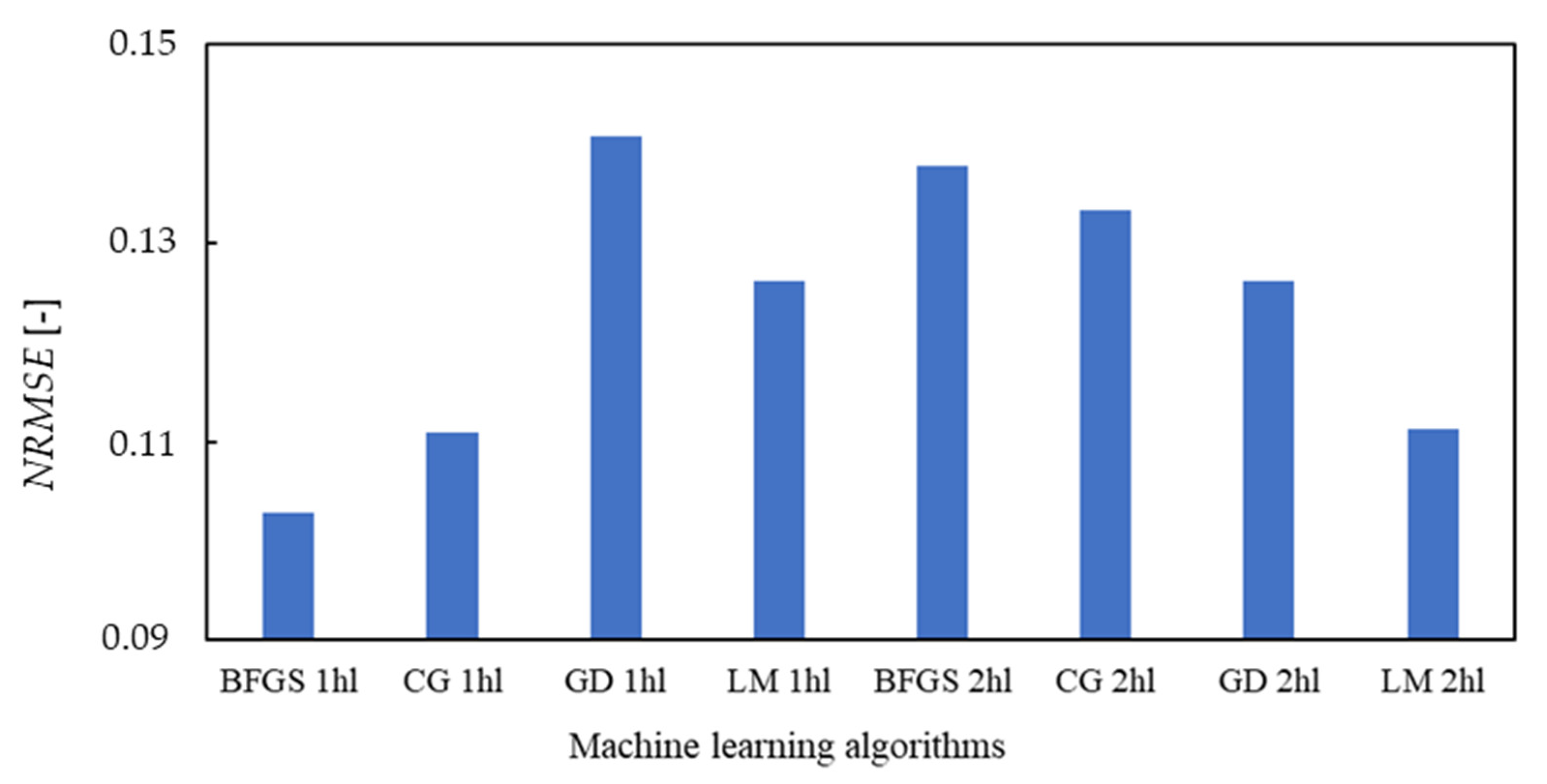
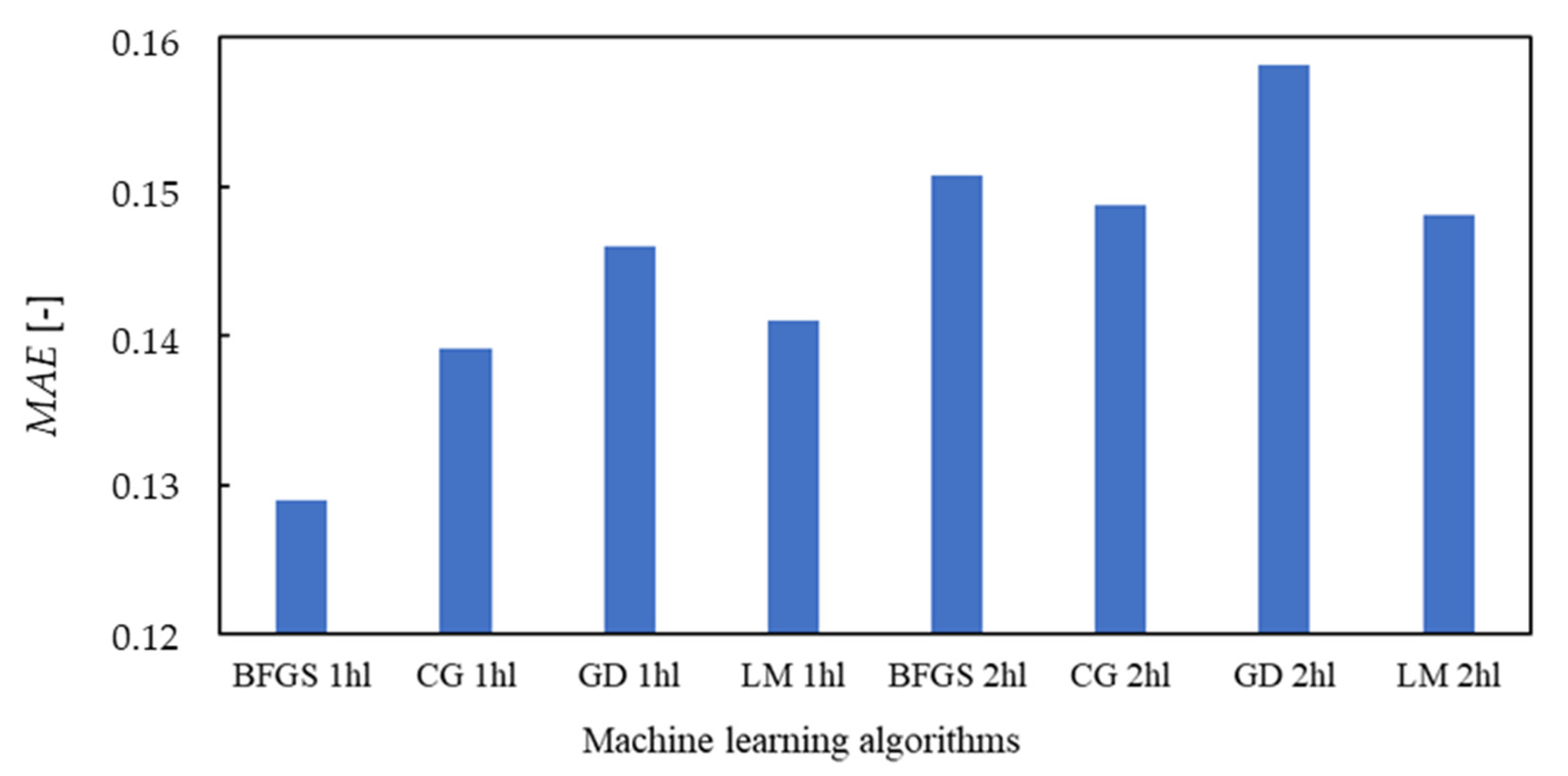

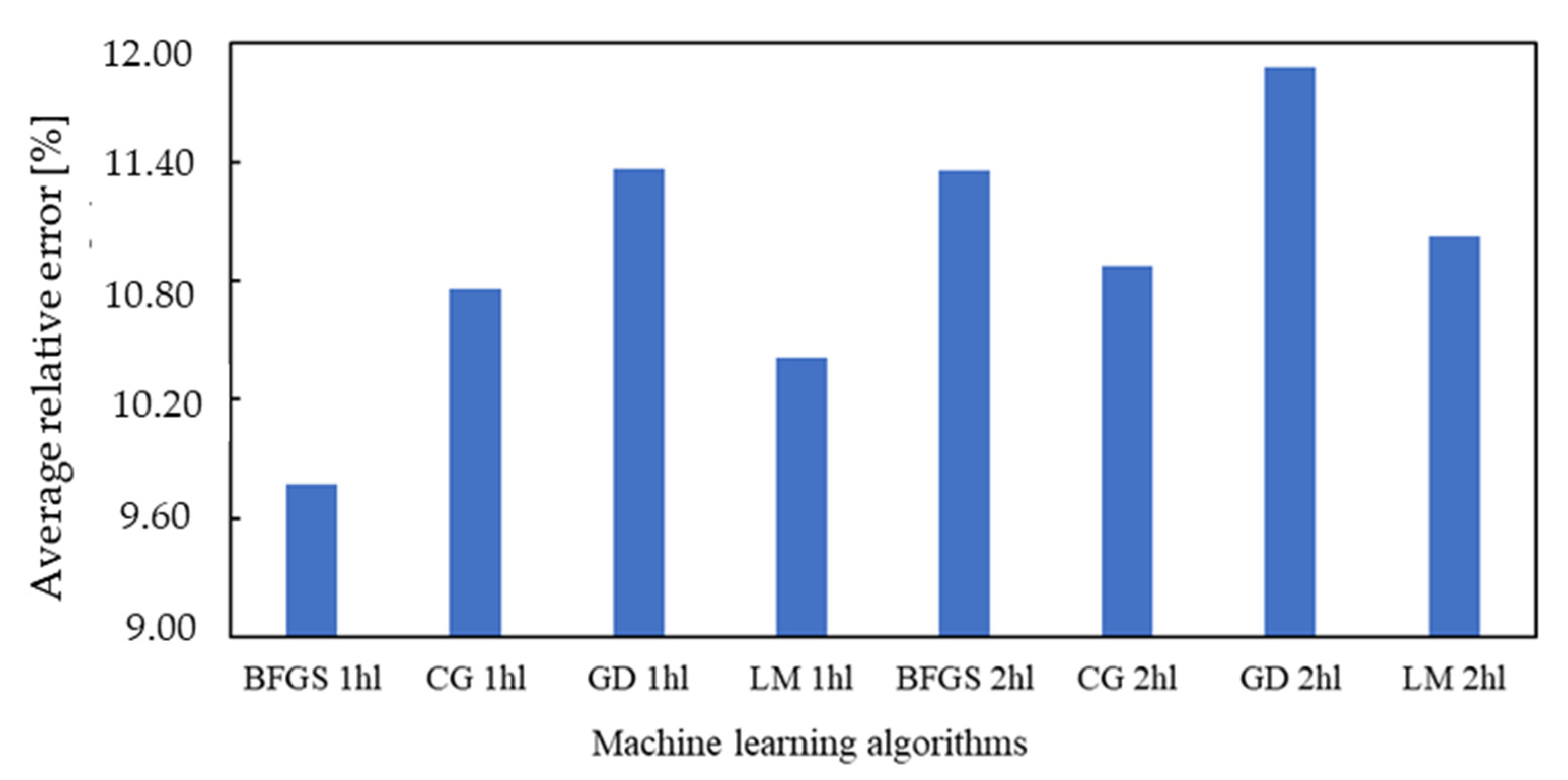
| Series [-] | Cement CEM I 42.5R [kg/m3] | Granite Powder [kg/m3] | Dry Quartz Sand [kg/m3] | Water [kg/m3] | W/C Ratio [-] |
|---|---|---|---|---|---|
| REF | 512.0 | 0.0 | 1536.0 | 256.0 | 0.50 |
| GP10 | 460.8 | 51.2 | 1536.0 | 256.0 | 0.56 |
| GP20 | 409.6 | 102.4 | 1536.0 | 256.0 | 0.63 |
| GP30 | 358.4 | 153.6 | 1536.0 | 256.0 | 0.71 |
| Descriptive Statistics | Cement [kg/m3] | Dry Quartz Sand [kg/m3] | Water [kg/m3] | Granite Powder [kg/m3] | Curing Time [days] | fc [MPa] | fh [MPa] |
|---|---|---|---|---|---|---|---|
| Min | 358.40 | 1536.00 | 256.00 | 0.00 | 56.00 | 14.00 | 0.70 |
| Max | 512.00 | 1536.00 | 256.00 | 153.60 | 90.00 | 38.00 | 3.08 |
| Mean | 435.20 | 1536.00 | 256.00 | 76.80 | 73.00 | 26.69 | 1.33 |
| Standard deviation | 57.39 | 0.00 | 0.00 | 57.39 | 17.04 | 4.49 | 0.44 |
| Spread | 153.60 | 0.00 | 0.00 | 153.60 | 34.00 | 24.00 | 2.38 |
| Variables | Input Parameters | Output Parameters | ||||||
|---|---|---|---|---|---|---|---|---|
| Cement | Granite Powder | W/C Ratio | Curing Method | Curing Time | fc | Pull-Off | ||
| Input | Cement | 1.00 | −1.00 | −0.99 | - | - | 0.32 | 0.56 |
| Granite Powder | −1.00 | 1.00 | 0.99 | - | - | −0.32 | −0.56 | |
| W/C ratio | −0.99 | −0.99 | 1.00 | - | - | −0.31 | −0.55 | |
| Curing method | - | - | - | 1.00 | - | 0.05 | 0.52 | |
| Curing time | - | - | - | - | 1.00 | - | 0.05 | |
| fc | 0.32 | −0.32 | −0.31 | 0.05 | - | 1.00 | 0.12 | |
| Output | Pull-off | 0.56 | −0.56 | −0.55 | 0.52 | 0.05 | 0.12 | 1.00 |
| Learning Algorithm | Number of Hidden Layres | Number of Hidden Neurons | R2 | NRMSE | MAE | MAPE |
|---|---|---|---|---|---|---|
| gradient descent | 1 | 2 | 0.7807 | 0.1408 | 0.1460 | 11.47 |
| gradient descent | 2 | 13–15 | 0.7386 | 0.1262 | 0.1582 | 11.87 |
| conjugate gradient | 1 | 3 | 0.8134 | 0.1109 | 0.1391 | 10.32 |
| conjugate gradient | 2 | 11–8 | 0.7734 | 0.1332 | 0.1488 | 10.87 |
| Broyden–Fletcher–Goldfarb–Shanno | 1 | 9 | 0.8399 | 0.1028 | 0.1290 | 9.87 |
| Broyden–Fletcher–Goldfarb–Shanno | 2 | 4–3 | 0.7657 | 0.1382 | 0.1507 | 11.35 |
| Levenberg–Marquardt | 1 | 7 | 0.7934 | 0.1261 | 0.1410 | 10.41 |
| Levenberg–Marquardt | 2 | 4–10 | 0.8046 | 0.1112 | 0.1481 | 11.02 |
Disclaimer/Publisher’s Note: The statements, opinions and data contained in all publications are solely those of the individual author(s) and contributor(s) and not of MDPI and/or the editor(s). MDPI and/or the editor(s) disclaim responsibility for any injury to people or property resulting from any ideas, methods, instructions or products referred to in the content. |
© 2023 by the authors. Licensee MDPI, Basel, Switzerland. This article is an open access article distributed under the terms and conditions of the Creative Commons Attribution (CC BY) license (https://creativecommons.org/licenses/by/4.0/).
Share and Cite
Czarnecki, S.; Moj, M. Comparative Analyses of Selected Neural Networks for Prediction of Sustainable Cementitious Composite Subsurface Tensile Strength. Appl. Sci. 2023, 13, 4817. https://doi.org/10.3390/app13084817
Czarnecki S, Moj M. Comparative Analyses of Selected Neural Networks for Prediction of Sustainable Cementitious Composite Subsurface Tensile Strength. Applied Sciences. 2023; 13(8):4817. https://doi.org/10.3390/app13084817
Chicago/Turabian StyleCzarnecki, Slawomir, and Mateusz Moj. 2023. "Comparative Analyses of Selected Neural Networks for Prediction of Sustainable Cementitious Composite Subsurface Tensile Strength" Applied Sciences 13, no. 8: 4817. https://doi.org/10.3390/app13084817
APA StyleCzarnecki, S., & Moj, M. (2023). Comparative Analyses of Selected Neural Networks for Prediction of Sustainable Cementitious Composite Subsurface Tensile Strength. Applied Sciences, 13(8), 4817. https://doi.org/10.3390/app13084817






